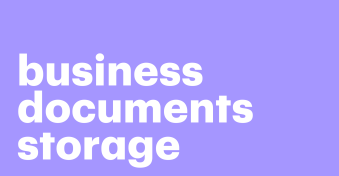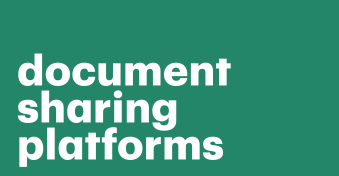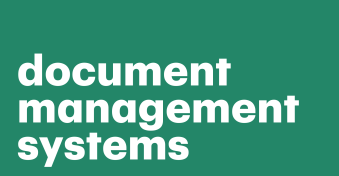You often create documents to close a deal — contracts, proposals, quotes.
The next thing you do? You send them over using email or via a messaging app.
You then need to verify if a person received your document.
You can get a tool to track email open rate or see if a recipient has indeed received your message in an app.
But did they do more than open it?
How much time did they spend reading it? What page did they spend most of the time on?
Document tracking provides these insights.
As part of a comprehensive document management system, this feature offers insights into how users interact with your document.
This article is about document tracking, its benefits and the ways to effectively track your docs using PandaDoc’s document management system.
Let’s start!
What is document tracking?
Before going in-depth, let’s outline what document tracking is.
Document tracking is a feature that tracks data on documents while they move through a team or company.
Doing so helps you automate accessing, searching, editing, and managing your documents.
It gives insights into who accessed your file; you can also limit who can view and edit the content.
Document tracking is available in two options: as a stand-alone document tracking system and as a feature of a document management system (DMS).
While a tracking system mainly focuses, like the name implies, on the tracking aspect, a document management system provides a range of features like collaboration, sharing, and editing with trackable actions.
Tracking is commonly used in the financial, legal and healthcare sectors.
They have volumes of confidential documents where data on an entire document lifecycle is crucial. It is also a beneficial tool for various teams.
If you work in sales, obtaining data on what page gained the most interest in your sales lead or marketing collateral will help you to build a better conversation.
Conversely, if your recipients skip some crucial pages — time to change how you put content on a page!
Benefits and features of document tracking
Document tracking has extensive advantages — let’s dig in.
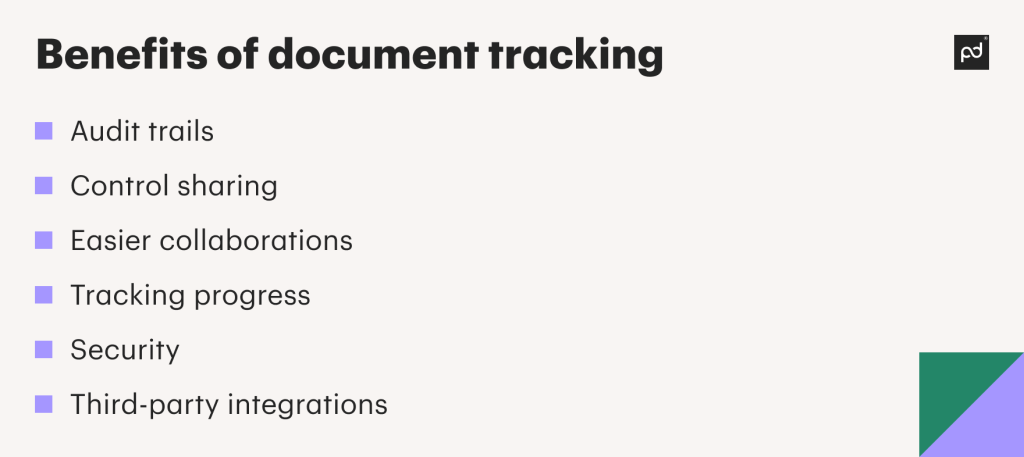
Audit trails
When we detect an issue in a document, the first thing we do is go to a record of changes.
This feature is available in a document management system as well.
When you share access to a document with multiple users, you can see a record of every user interaction.
Who opened it and when, what changes they made in a document and where.
If there is unauthorized access to a document, it will be shown in an audit trail as well.
This is what makes an audit trail such a favorite feature for teams that manage policies and contracts.
Control sharing
When you create policies and sensitive documents, you need to be careful with whom you share these docs.
With a document management system in place, you can determine a list of collaborators, recipients, and decide what they can do with a document: view, comment or full editing capabilities.
Easier collaborations
We all create documents faster when collaborating with teams and departments.
In a DMS, you can chat with people using a private or public chat when drafting a common document, or leave suggestions on a page.
Tracking progress
Document tracking helps to see what progress has been made on a document.
If you have already sent a document for review, there is no need to write an email asking about the progress.
You will see this information in your dashboard. You can also enable automatic reminders that will be sent to those who may be slowing down progress.
Security
Many document management systems put security front and center.
They follow important regulations under HIPAA, Sarbanes-Oxley, FDA Good Manufacturing Practices or ISO 9000/9001 to provide you with more secure experiences when creating documents.
Third-party integrations
As a rule, DMS includes third-party integrations to boost productivity of teams.
Such tools like a CRM, accounting software or a calendar enables a seamless transfer of information across all your departments.
How do you best track documents?
1. Get the right document management system
First things go first — you need to get a document management system to leverage document tracking.
A well-designed DMS comes with a range of features that make the whole experience of creating a document smoother.
A template library of useful docs like contracts, proposals, forms, etc., is helpful here.
PandaDoc has a ton of them, and instead of creating content from scratch, you can save useful ones in the Content Library and reuse them in the future.
A streamlined approval workflow helps you to shift a document through necessary stages fast, and third-party integrations connect your documents and data in flash.
All these features and more are available in PandaDoc’s document management system.
2. Assign roles to internal and external stakeholders
Sharing a document is an ideal way to collaborate with teammates within a workspace.
With Internal Granular Permissions, you can invite anyone inside your company to view, edit and share a document without giving them an all-access pass to your workspace.
With an existing PandaDoc account, you can assign the following roles to users on that account:
Member — can send and view their own documents and other’s templates
Manager — can send and view documents created by members in the same workspace. Can also add new people to the workspace.
Admin — has full access to the workspace and workspace settings
Activities that your team members perform get tracked in a system.
When you click on a single collaborator, you can evaluate how effective they have been at processing a document.
You can invite your customers to collaborate in a document too.
With External Granular Permissions, you can be sure it is done in a secure and safe way.
You don’t even need to purchase a separate license or grant them full access to a document in a workspace.
3. Leverage a collaboration tool and track activity
After you designate roles, your team members can move a document in the right direction with comments and chat features.
- Leave inline comments and suggest edits in specific sections of a document. If you tag another colleague within your workspace, they will get a notification. If you resolve a comment, it can be easily found in history.
- Collaborate in chat. Talk to your team in a chat when drafting a document. Even if you get back to a chat the next day, its history will appear on a screen.
Whenever you work with multiple people on a document, you can easily access version history.
It’s a feature that tracks changes made to the page and specifies who made them.
If multiple users are editing simultaneously and one of them exits a document, its version history will be saved before they close a document.
It’s also a must-have feature for cases like when you accidentally delete a paragraph (or ten) — instead of frantically clicking buttons to try and undo mistakes, simply go to the version history.
Version history becomes available:
- After you’ve opened a document, edited it, and closed it
- When a document is sent
- When a document is restored
- When a suggestion added to a document is accepted
- When the redlining process is finalize
4. Enable notifications to see when recipients open your document
Ok — you’ve got your document sent out, the analytics section will soon start generating numbers and clicks. What’s next?
More often than not, you’ll want to enable notifications to see when your document was opened. In PandaDoc, there are two options:
- First time the document is opened by a recipient
- Every time the document is opened by a recipient
That way, you know when to best plan the follow up email.
Or if you are in a meeting, you can receive emails instead of going to the system and checking there.
You can also access other options for tracking documents, such as:
- Document is completed by a recipient
- Comment is posted
- Suggestion is added
When enabling the notifications feature, you stay updated on the status of your document immediately — no delays!
5. Access recipient behavior analytics
When receivers interact with a document, it gets tracked in the system.
Tracking recipient analytics gives you the full picture of how your document performs.
The analytics provide a window into:
- How many times the document has been viewed
- Total time spent on viewing it
- When it was last viewed
- Whether it was downloaded
- Any links that were clicked
Seeing analytics is helpful.
You realize what is working and what isn’t for your customers and how you can improve content.
For example, if you see that recipients skip the same pages, it is a signal that you need to make those pages more interactive and collaborate with a marketing team.
If you’re in HR, you seek ways to improve your job offers if you see that potential candidates review the same page a few times and still hesitate to make up their mind.
6. Know how your document performs
Seeing recipient behavior is just as helpful as having analytics about a document’s total overall performance.
Specifically, you get access to:
- Workflow overview. It helps to understand your document funnel inside and out. Data can be filtered by workspace and time period.
- Document progress. Analytics into how many created documents have been sent and completed.
- Status transition time. It shows the amount of time it takes your team to prepare and send a document, as well as how long to complete it. It can be filtered by one status (created -> send -> completed) too.
- Data analytics. A comprehensive analysis into the workspace, document creator, and template used to create a document, and the document name.
Having tracking in place helps to see how a document performs.
When you log into PandaDoc, the first thing you see is the Dashboard — an overview of your pipeline and statuses for each tile.
Having them in front of you helps to see the real picture and make corrections to processes.
You can export data into CSV files or have them in a system.
This is what your stakeholders need to see when analyzing your team’s progress.
You can transform raw data into actionable insights, charts, and graphs that highlight the most important takeaways to decision-makers.
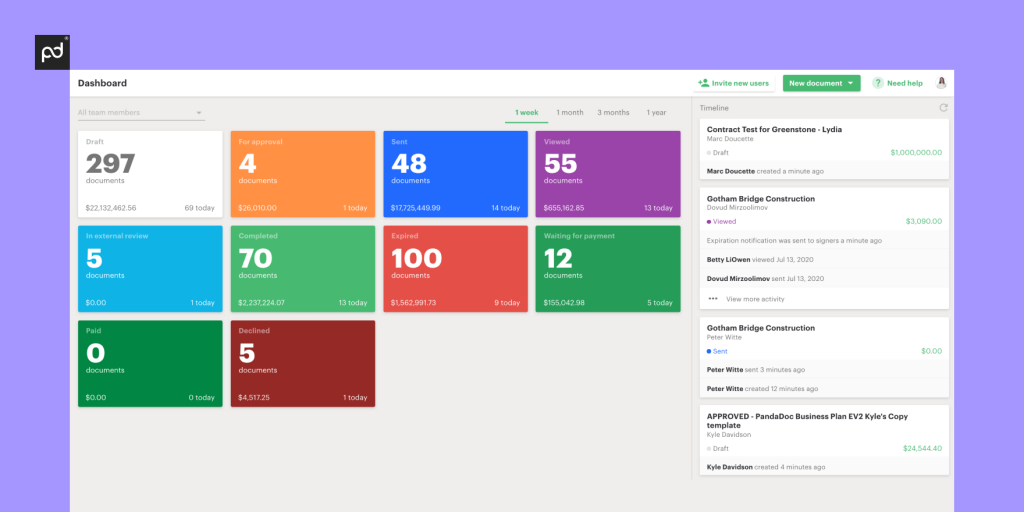
7. Store all documents in our sharable space
A final step in this guide: store your documents in one sharable space.
That way, you have the ability to access your files fast. But that’s not all.
The dashboard feature shows you insights into your team’s pipeline.
It has tiles that show recent documents that are sorted by their current status: draft, for approval, sent, viewed, and more.
You can filter these documents by a team member and time frame — 1 week, 1 month, 3 months, and 1 year.
There is a timeline feature that gives a quick summary into recent activity on documents, such as comments and actions.
Expertly keep eyes on your documents with PandaDoc’s document management system
Document tracking and a DMS supplement each other in their best.
While tracking obtains data on documents only, a document management system helps to leverage this data and improve how a team operates.
This is what the PandaDoc solution does, and does very well.
It offers a modern UI accompanied with features like collaboration and negotiation that help to track documents and keep everyone updated.
Try out PandaDoc DMS to facilitate the process of tracking a document — request a free demo today!
Disclaimer
PandaDoc is not a law firm, or a substitute for an attorney or law firm. This page is not intended to and does not provide legal advice. Should you have legal questions on the validity of e-signatures or digital signatures and the enforceability thereof, please consult with an attorney or law firm. Use of PandaDocs services are governed by our Terms of Use and Privacy Policy.
